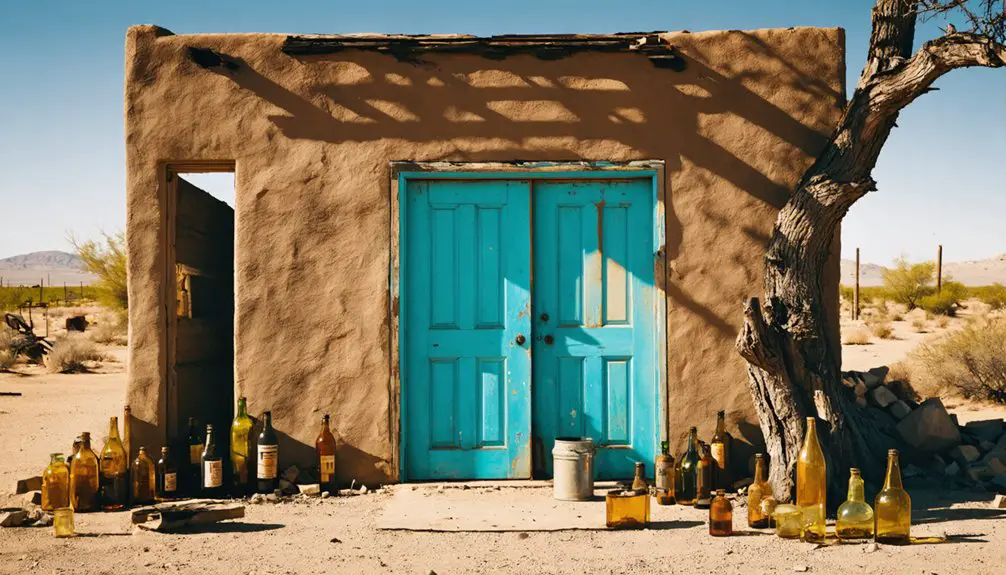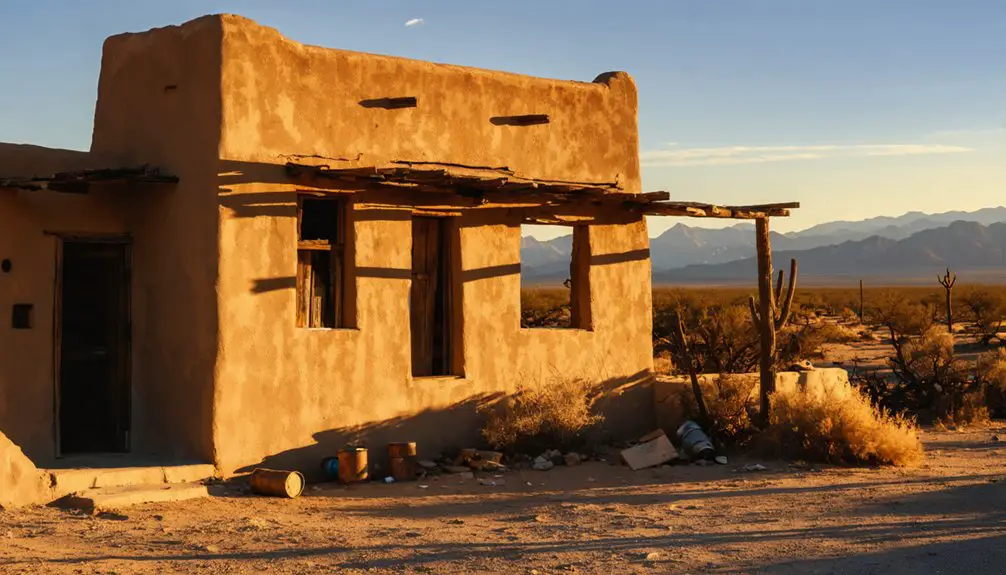You’ll find Cuchillo in Sierra County, New Mexico, where Apache chief Baishan ruled until 1857. Spanish settlers arrived by 1867, transforming it into a bustling mining hub with 2,000 residents by the 1880s. The town’s historic landmarks include the Old Cuchillo Bar (1850s) and San Jose Catholic Church (1907). Though most residents departed after silver’s demonetization in the 1890s, the ghost town’s preserved structures hold tales of paranormal activity and hidden treasures.
Key Takeaways
- Cuchillo was a thriving frontier town in the 1880s with nearly 2,000 residents before declining after the silver market collapse.
- The historic Old Cuchillo Bar and Store complex, dating from the 1850s, remains a landmark despite closing in 2004.
- The town served as an important stage stop and trading center between silver mines, ranches, and major settlements.
- Multiple ghost sightings and paranormal activities have been reported in the Old Cuchillo Bar for over 150 years.
- Located in a semi-arid valley at 4,800 feet elevation, water scarcity contributed to Cuchillo’s transformation into a ghost town.
The Apache Legacy and Early Settlement
While the Mimbres Indians first occupied the Cuchillo Valley until 1200 AD, the Apache emerged as the dominant force in the region by the early 1600s.
Under the leadership of chiefs like Baishan (Cuchillo Negro), Apache influence shaped the territory’s identity, leaving an indelible mark on its geography and culture. The chieftain lived until 1857, leading his people during a time of significant territorial changes.
Under the fierce Apache chief Baishan, known as Cuchillo Negro, this untamed territory was forever transformed through generations of tribal dominance.
You’ll find that settlement patterns shifted dramatically around 1855 when the Apache abandoned the area.
Spanish settlers from Canada Alamosa quickly moved in, establishing farms along Cuchillo Negro Creek by 1867.
These early colonists arranged their settlement around a central plaza – a defensive formation against potential raids.
By the late 1880s, the thriving community reached its peak with nearly 2000 residents.
Life During the Mining Boom Years
As silver mining operations expanded throughout the region in the 1880s, Cuchillo transformed from a modest Hispanic farming settlement into a bustling commercial hub of nearly 2,000 residents.
You’d have found a thriving mining culture centered around essential services for the region’s miners, cowboys, and travelers.
The town’s vibrant social fabric included:
- The Old Cuchillo Bar, where you could swap tales with miners after their shifts
- Saint Joseph Catholic Church, hosting community gatherings from weddings to funerals
- The post office, established in 1883, serving as the heart of daily communication
While Cuchillo wasn’t a mining town itself, it flourished as a critical trading center and stagecoach stop.
Merchants, farmers, and service providers created a dynamic economy that supported the surrounding mining operations until silver’s demonetization in the 1890s.
The town was named after the respected Warm Springs Apache chief who led his people through the surrounding territory.
Today, this living ghost town maintains a small but resilient population of about 35 residents.
Historic Buildings and Landmarks
Despite more than a century of exposure to the harsh New Mexico elements, several notable historic structures in Cuchillo still stand as evidence to the town’s prosperous trading era.
You’ll find the Old Cuchillo Bar and Store complex, dating from the 1850s, which served as both a social hub and essential stage stop along the Armstrong Brothers line until 2004.
The San Jose Catholic Church, rebuilt in 1907, represents historic preservation at its finest with its traditional adobe construction and architectural significance.
Standing since 1907, San Jose Catholic Church showcases masterful adobe construction that embodies the preservation of New Mexico’s architectural heritage.
Near the old commercial center, you’ll discover ruins of the post office established in 1883, an abandoned dance hall, and former lodging facilities.
These buildings, though weathered, tell the story of frontier life, from Ed Fest’s legendary treasure-protecting boarding house to the once-bustling saloon that attracted cowboys and miners alike.
A devastating electrical fire in 2000 caused significant damage to portions of the historic Bar and Store complex, yet the structure remains an important landmark in the community.
The town’s location midway between Chloride and Engle made it an ideal trading post during its peak years from the 1880s to 1930s.
Haunted Tales From the Old Bar
If you’re examining the haunted history of the Old Cuchillo Bar after 2004, you’ll discover numerous documented accounts of paranormal activity spanning more than 150 years.
Your investigation of the bar’s spectral residents will reveal reports of ghostly figures, unexplained sounds, and mysterious presences that seem to echo the establishment’s rich history of gamblers, miners, and travelers.
A devastating fire in 2000 forced the historic saloon to permanently close its doors just four years later.
The bar’s reputation as a haunted location has attracted paranormal investigators who’ve documented evidence suggesting that some of the former patrons never truly left, even after the establishment closed its doors.
Spirits Behind the Bar
The old Cuchillo Bar and Store, established in the 1850s, harbors some of New Mexico’s most intriguing paranormal activity.
During its peak from the 1880s to early 1900s, the establishment served as a bustling waypoint for miners and cowboys, many of whom met tragic ends in the dangerous frontier.
You’ll find that ghostly encounters persist even after the bar’s 2004 closure.
Notable spectral sightings include:
- Apparitions of former patrons lingering near the well-worn card table
- Unexplained sounds of clinking glasses and whispered conversations in the empty bar
- Cold spots and mysterious object movements, particularly around Ed Fest’s rumored treasure locations
The bar’s artifacts and original fixtures remain intact, preserving what many believe to be spiritual echoes of its tumultuous past, beckoning those who dare to investigate.
Mysterious Late-Night Encounters
Nightfall at the Old Cuchillo Bar & Store brings forth a different kind of patron – one that hasn’t walked among the living since the 1800s. As darkness descends, ghostly whispers and the distinct sounds of clinking glasses echo through the abandoned saloon, particularly near the notorious card table where miners once gambled their fortunes away.
You’ll encounter shadowy figures in period attire materializing near the entrance and the ruins of the adjacent dance hall. These apparitions, often appearing as cowboys and miners, seem to reenact scenes from the town’s mining era.
Electromagnetic disturbances and unexplained cold spots intensify after midnight, while chairs mysteriously shift positions. Paranormal investigators have captured compelling audio recordings of disembodied voices, preserving evidence of the supernatural activity that continues to define this historic establishment.
Hidden Treasures and Local Legends

During territorial times around 1850, you’d find Ed Fest operating a prosperous boarding house in Cuchillo, where he safeguarded valuable possessions for travelers crossing dangerous Apache territory.
When many travelers never returned to claim their belongings, Ed’s mounting collection of unclaimed valuables sparked persistent local legends about a hidden fortune concealed somewhere on the property.
Historical records confirm treasure hunters have extensively searched the site, even dismantling a wall, though no documented discoveries exist beyond speculation that successful seekers may have quietly departed with their finds.
Ed Fest’s Secret Fortune
Legends surrounding Ed Fest’s secret fortune emerged during Cuchillo’s late 19th-century heyday as a bustling stage stop and mining waypoint.
You’ll find this tale deeply intertwined with Apache history, particularly through connections to Chief Cuchillo Negro and the territorial conflicts that defined the era.
While treasure hunting expeditions haven’t yielded documented success, historical evidence suggests multiple potential cache locations:
- The Old Cuchillo Bar and store complex
- Caves within the nearby Black Range mountains
- Areas along Cuchillo Creek’s historic farmlands
Ed Fest’s legacy joins other regional mysteries, like the Victorio Peak treasure and Lost Padre Mine. System verification checks are currently being conducted on several reported treasure sites.
The violent backdrop of Apache-settler conflicts and mining disputes has led many to believe that valuable caches remain hidden, deliberately concealed to protect wealth during turbulent times.
Boarding House Money Trail
The Cuchillo boarding house, intimately linked to the Old Cuchillo Bar & Store complex, holds its own treasury of hidden wealth stories separate from Ed Fest’s fortune.
Elephant Butte Dam workers frequented the boarding house during construction from 1911 to 1916, adding to the potential of concealed valuables in the walls and floorboards.
As a bustling stopover between 1880 and 1930, the boarding house served countless miners, cowboys, and travelers who might’ve stashed valuables within its wooden frame and adobe walls.
You’ll find money legends deeply woven into the town’s fabric, with treasure seekers drawn to the possibilities of unclaimed riches left behind by transient guests.
While no documented discoveries exist, the boarding house’s strategic location near the former post office and saloon fuels speculation about concealed wealth.
Though a 2000 electrical fire damaged parts of the complex and private ownership limits exploration, the stories continue to captivate those seeking forgotten fortunes in this historic New Mexico waypoint.
Apache Territory Valuables
While Baishan, the feared Warm Springs Apache chief known as “Black Knife,” controlled the Cuchillo territory from the 1830s to 1857, his warriors’ raids against Mexican settlers and miners generated countless tales of hidden spoils. Under Mangas Coloradas’ leadership, Baishan conducted extensive raids into Sonora and Chihuahua, potentially accumulating significant plunder.
You’ll find the most persistent legends of Apache valuables centered around three documented events:
- The 1870s uprising that forced settlers to retreat, leaving behind possessions the Apache may have collected and concealed.
- The mining boom of the 1880s, when Victorio’s resistance led to strategic caching of raided treasures.
- The defensive actions at Plaza Cuchillo Negro, where Spanish settlers’ valuable items were reportedly seized during Apache raids.
These Cuchillo treasures remain undocumented in historical records, yet the oral traditions persist, intertwining with the broader narrative of Apache resistance against territorial encroachment.
Natural Challenges and Geographic Significance
Situated within a semi-arid valley at 4,800 feet elevation, Cuchillo faced persistent environmental challenges that shaped its development and eventual decline.
You’ll find that while Cuchillo Negro Creek initially provided water for over 100 farms between 1880-1920, the settlement constantly battled water challenges including seasonal fluctuations and destructive flooding.
Despite these obstacles, Cuchillo’s geographic advantages made it an attractive waypoint. Located 15 miles northwest of Truth or Consequences near Interstate 25, the town served travelers between Winston and Chloride.
The surrounding Black Range mountains offered mineral resources, while the valley’s arable land supported early settlement. However, the harsh climate, marked by hot summers and cold winters, combined with ongoing water scarcity, ultimately contributed to the area’s transformation from thriving community to ghost town.
Frequently Asked Questions
What Is the Current Population of Cuchillo, New Mexico?
You’ll find the current demographics hard to pin down precisely, but historical significance suggests Cuchillo’s permanent population is minimal to zero, contradicting unverified claims of 7,139 residents in this ghost town.
Are There Any Accommodations or Camping Facilities Near Cuchillo?
You’ll find limited accommodation at the Old Cuchillo Bar and Hotel, plus a vintage trailer rental. For camping options, you’re better off exploring nearby Truth or Consequences’s facilities and attractions.
How Accessible Is Cuchillo by Car During Different Seasons?
You’ll find year-round car access via maintained highways, though winter storms can bring challenging conditions. Spring through fall offers ideal driving, while winter requires attention to seasonal conditions and road maintenance alerts.
Can Visitors Enter and Explore the Abandoned Buildings Legally?
Like a locked treasure chest of history, ghost town regulations protect these time capsules. You can’t legally enter abandoned buildings without explicit property owner permission, preserving their historical significance for generations.
Are There Guided Tours Available of the Historic Town Site?
You’ll find guided explorations are irregularly available through the property owner by appointment, though scheduling can be challenging. The site’s historical significance draws interest, but no formal tour programs exist.
References
- https://newmexiconomad.com/cuchillo-new-mexico/
- https://cityofdust.blogspot.com/2012/04/by-wayside-cuchillo-new-mexico.html
- https://en.wikipedia.org/wiki/Cuchillo
- https://elchuqueno.com/city-of-dust-cuchillo-new-mexico/
- https://sierracountynewmexico.info/cool-places/cuchillo-new-mexico/
- https://en.wikipedia.org/wiki/Baishan_(Apache)
- https://blackrange.org/the-natural-history-of-the/trails/between-the-river-and-the.pdf
- https://4girlsandaghost.wordpress.com/2012/02/27/old-cuchillo-bar-and-store/
- https://agmc.info/wp-content/uploads/simple-file-list/New-Mexico-documents/New_Mexico_Mining_History.pdf
- https://www.newmexicomagazine.org/blog/post/things-to-do-old-mining-towns-new-mexico/



